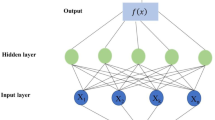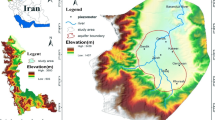Abstract
Farmers and stakeholders who use groundwater for irrigation need efficient and cost-effective tools to support sustainable crop production. The variation of groundwater levels at local scale and its continuous use for agriculture intensifies the demand for reliable groundwater information. However, groundwater levels are very dynamic and difficult to predict under traditional modeling approaches, and manual monitoring of wells is costly and time-consuming. Simplified but powerful machine learning models represent a practical alternative to support groundwater management decisions at the farm scale. The predictive capacity of a nonlinear autoregressive with exogenous inputs (NARX) artificial neural network (ANN) and a support vector regression (SVR) trained with a radial basis function (RBF) algorithm were evaluated for an irrigation well located in a highly productive agricultural region in the southeastern USA. We used separately multiple years of daily historical time series classified by summer (withdrawal) and winter (recharge) seasons and evaluated the impacts of this division in the models’ predictive capability. Results showed that SVR had a better modeling performance based on the mean squared error (MSE) and prediction trend for both seasons. In addition, our study suggests that the prediction of daily levels with input time series classified by seasons provides higher accuracy than using the entire withdrawal and recharge periods as a whole. Results also indicate that the recharge season becomes a linear problem, which substantially reduces the SVR modeling computational requirements. The application of our proposed modeling approach in the management of groundwater sources for irrigation provides important information, at short time scale, for the estimation of groundwater variability at local scale.









Similar content being viewed by others
References
Nayak, P. C., Sudheer, K. P., Rangan, D. M., & Ramasastri, K. S. (2004). A neuro-fuzzy computing technique for modeling hydrological time series. Journal of Hydrology, 291(1–2), 52–66. https://doi.org/10.1016/j.jhydrol.2003.12.010.
Lima, M. L., Romanelli, A., & Massone, H. E. (2015). Assessing groundwater pollution hazard changes under different socio-economic and environmental scenarios in an agricultural watershed. Science of the Total Environment, 530–531, 333–346. https://doi.org/10.1016/j.scitotenv.2015.05.026.
Govindaraju, R. S., & Rao, A. R. (2013). Artificial neural networks in hydrology (Vol. 36): Springer Science & Business Media.
Behzad, M., Asghari, K., Eazi, M., & Palhang, M. (2009). Generalization performance of support vector machines and neural networks in runoff modeling. Expert Systems with Applications, 36(4), 7624–7629. https://doi.org/10.1016/j.eswa.2008.09.053.
Dibike, Y., Velickov, S., Solomatine, D., & Abbott, M. (2001). Model induction with support vector machines: Introduction and applications. Journal of Computing in Civil Engineering, 15(3), 208–216. https://doi.org/10.1061/(ASCE)0887-3801(2001)15:3(208).
Dyer, J., Mercer, A., Rigby, J. R., & Grimes, A. (2015). Identification of recharge zones in the lower Mississippi River alluvial aquifer using high-resolution precipitation estimates. Journal of Hydrology, 531, Part 2, 360–369, doi:https://doi.org/10.1016/j.jhydrol.2015.07.016.
Powers, S. (2007). Agricultural water use in the Mississippi Delta. http://www.ymd.org/pdfs/wateruse/Agricultural%20Water%20Use%20Presentation.pdf Accessed February 28, 2018.
Dakhlalla, A. O., Parajuli, P. B., Ouyang, Y., & Schmitz, D. W. (2016). Evaluating the impacts of crop rotations on groundwater storage and recharge in an agricultural watershed. Agricultural Water Management, 163, 332–343. https://doi.org/10.1016/j.agwat.2015.10.001.
Karamouz, M., Kerachian, R., & Zahraie, B. (2004). Monthly water resources and irrigation planning: case study of conjunctive use of surface and groundwater resources. Journal of Irrigation and Drainage Engineering, 130(5), 391–402. https://doi.org/10.1061/(ASCE)0733-9437(2004)130:5(391).
Scanlon, B. R., Faunt, C. C., Longuevergne, L., Reedy, R. C., Alley, W. M., McGuire, V. L., & McMahon, P. B. (2012). Groundwater depletion and sustainability of irrigation in the US High Plains and Central Valley. Proceedings of the National Academy of Sciences, 109(24), 9320–9325.
Coulibaly, P., Anctil, F., Aravena, R., & Bobée, B. (2001). Artificial neural network modeling of water table depth fluctuations. Water Resources Research, 37(4), 885–896. https://doi.org/10.1029/2000wr900368.
Daliakopoulos, I. N., Coulibaly, P., & Tsanis, I. K. (2005). Groundwater level forecasting using artificial neural networks. Journal of Hydrology, 309(1–4), 229–240. https://doi.org/10.1016/j.jhydrol.2004.12.001.
Asefa, T., Kemblowski, M., McKee, M., & Khalil, A. (2006). Multi-time scale stream flow predictions: The support vector machines approach. Journal of Hydrology, 318(1–4), 7–16. https://doi.org/10.1016/j.jhydrol.2005.06.001.
Barzegar, R., Fijani, E., Moghaddam, A. A., & Tziritis, E. (2017). Forecasting of groundwater level fluctuations using ensemble hybrid multi-wavelet neural network-based models. Science of the Total Environment, 599-600, 20–31. https://doi.org/10.1016/j.scitotenv.2017.04.189.
Maier, H. R., & Dandy, G. C. (2000). Neural networks for the prediction and forecasting of water resources variables: a review of modelling issues and applications. Environmental Modelling & Software, 15(1), 101–124. https://doi.org/10.1016/S1364-8152(99)00007-9.
Basak, D., Pal, S., & Patranabis, D. C. (2007). Support vector regression. Neural Information Processing-Letters and Reviews, 11(10), 203–224.
Yoon, H., Jun, S.-C., Hyun, Y., Bae, G.-O., & Lee, K.-K. (2011). A comparative study of artificial neural networks and support vector machines for predicting groundwater levels in a coastal aquifer. Journal of Hydrology, 396(1–2), 128–138. https://doi.org/10.1016/j.jhydrol.2010.11.002.
Khan, M. S., & Coulibaly, P. (2006). Application of support vector machine in lake water level prediction. Journal of Hydrologic Engineering, 11(3), 199–205.
Bray, M., & Han, D. (2004). Identification of support vector machines for runoff modelling. Journal of Hydroinformatics, 6(4), 265–280.
Arabgol, R., Sartaj, M., & Asghari, K. (2016). Predicting nitrate concentration and its spatial distribution in groundwater resources using support vector machines (SVMs) model. Environmental Modeling & Assessment, 21(1), 71–82.
Barzegar, R., Asghari Moghaddam, A., Adamowski, J., & Fijani, E. (2017). Comparison of machine learning models for predicting fluoride contamination in groundwater. Stoch Environ Res Risk Assess, 31(10), 2705–2718. https://doi.org/10.1007/s00477-016-1338-z.
Ganguli, P., & Reddy, M. J. (2014). Ensemble prediction of regional droughts using climate inputs and the SVM–copula approach. Hydrological Processes, 28(19), 4989–5009.
Barzegar, R., Fijani, E., Moghaddam, A. A., & Tziritis, E. (2017b). Forecasting of groundwater level fluctuations using ensemble hybrid multi-wavelet neural network-based models. Science of the Total Environment, 599–600, 20–31.
Piotrowski, A. P., & Napiorkowski, J. J. (2012). A comparison of methods to avoid overfitting in neural networks training in the case of catchment runoff modelling. Journal of Hydrology, 476, 97–111. https://doi.org/10.1016/j.jhydrol.2012.10.019.
Izady, A., Davary, K., Alizadeh, A., Moghaddam Nia, A., Ziaei, A. N., & Hasheminia, S. M. (2013). Application of NN-ARX model to predict groundwater levels in the Neishaboor plain, Iran. Water Resources Management, 27(14), 4773–4794.
MathWorks, I. (2013). MATLAB R2013a. (8.1.0.604 ed.): The MathWorks Inc.
Kingston, G. B., Lambert, M. F., & Maier, H. R. (2005). Bayesian training of artificial neural networks used for water resources modeling, Water Resour. Res., 41, W12409. https://doi.org/10.1029/2005WR004152.
Cortes, C., & Vapnik, V. (1995). Support-vector networks. Machine Learning, 20(3), 273–297. https://doi.org/10.1007/BF00994018.
Raghavendra, N. j., & Deka, P. C. (2014). Support vector machine applications in the field of hydrology: A review. Applied Soft Computing, 19(0), 372–386. https://doi.org/10.1016/j.asoc.2014.02.002.
Guzman, S.M., Paz, J.O., Tagert, M.L.M. & Mercer, A.E. (2015). Artificial neural networks and support vector machines: contrast study for groundwater level prediction. 2015 ASABE annual international meeting paper 152181983. doi:https://doi.org/10.13031/aim.20152181983.
Guzman, S. M., Paz, J. O., Tagert, M. L. M., Mercer, A. E., & Pote, J. W. (2018). An integrated SVR and crop model to estimate the impacts of irrigation on daily groundwater levels. Ag Systems, 159, 248–259. https://doi.org/10.1016/j.agsy.2017.01.017.
Guzman, S. M., Paz, J. O., & Tagert, M. L. M. (2017). The use of NARX neural networks to forecast daily groundwater levels. Water Resources Management, 31(5), 1591–1603. https://doi.org/10.1007/s11269-017-1598-5.
Yu, P.-S., Chen, S.-T., & Chang, I. F. (2006). Support vector regression for real-time flood stage forecasting. Journal of Hydrology, 328(3–4), 704–716. https://doi.org/10.1016/j.jhydrol.2006.01.021.
Cherkassky, V., & Ma, Y. (2004). Practical selection of SVM parameters and noise estimation for SVM regression. Neural Networks, 17(1), 113–126.
Guzman, S.M., Paz, J.O., Tagert, M.L.M. & Wu, R. (2014). A neural network framework to estimate groundwater levels in the Mississippi river valley shallow alluvial aquifer Paper presented at the annual meeting of the Am. Soc. Agric. Biol. Eng., Montreal, Quebec. 13–16 July. ASABE, St. Joseph, MI. ASABE Paper No. 141897470. doi: https://doi.org/10.13031/aim.20141897470
Maupin, M. A., & Barber, N. L. (2005). Estimated withdrawals from principal aquifers in the United States, 2000 [electronic resource] / by Molly A. Maupin and Nancy L. Barber (Circular: 1279): Reston, Va.: U.S. Dept. of the Interior, U.S. Geological Survey: Denver, CO.
Quality, M. D. o. E. (2007). Groundwater Permitting and Monitoring http://www.deq.state.ms.us/MDEQ.nsf/page/L&W_Permitting_and_Monitoring?OpenDocument. Accessed July 2016.
USGS, U. S. G. S. (2001). National Water Information System data available on the World Wide Web (Water Data for the Nation). http://waterdata.usgs.gov/nwis/. Accessed Jun 15 2013.
National Climatic Data Center (2005). http://www.ncdc.noaa.gov/cdo-web/datasets/GHCND/stations/GHCND:USC00226009/detail. Accessed March 2014.
Woli, P., & Paz, J. O. (2012). Evaluation of various methods for estimating global solar radiation in the southeastern United States. Journal of Applied Meteorology and Climatology, 51(5), 972–985. https://doi.org/10.1175/JAMC-D-11-0141.1.
Nayak, P., Rao, Y. R. S., & Sudheer, K. P. (2006). Groundwater level forecasting in a shallow aquifer using artificial neural network approach. Water Resources Management, 20(1), 77–90. https://doi.org/10.1007/s11269-006-4007-z.
Yang, Z. P., Lu, W. X., Long, Y. Q., & Li, P. (2009). Application and comparison of two prediction models for groundwater levels: a case study in Western Jilin Province, China. Journal of Arid Environments, 73(4–5), 487–492. https://doi.org/10.1016/j.jaridenv.2008.11.008.
Acknowledgements
The authors would like to acknowledge Ruiyi Wu for his contribution in the code development, Hazel Buka for her contribution with the descriptive figures, and Juan Perez-Gutiérrez for his suggestions during the preparation of this paper. Special thanks are due to the anonymous reviewers for their valuable comments that helped improve the paper.
Funding
This material is based upon work that is supported by the National Institute of Food and Agriculture, US Department of Agriculture, Hatch project under accession number 227246.
Author information
Authors and Affiliations
Corresponding author
Rights and permissions
About this article
Cite this article
Guzman, S.M., Paz, J.O., Tagert, M.L.M. et al. Evaluation of Seasonally Classified Inputs for the Prediction of Daily Groundwater Levels: NARX Networks Vs Support Vector Machines. Environ Model Assess 24, 223–234 (2019). https://doi.org/10.1007/s10666-018-9639-x
Received:
Accepted:
Published:
Issue Date:
DOI: https://doi.org/10.1007/s10666-018-9639-x




